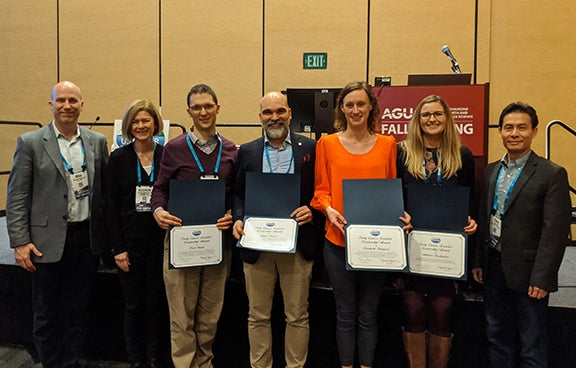2019 US CLIVAR Early Career Scientist Leadership Award Recipients

2019 marked the inaugural year of the US CLIVAR Early Career Scientist Leadership Awards that sought to recognize early career members of the US Earth system science community for their contributions to leading community activities to advance science on the role of the ocean in climate variability and predictability. Due to the outstanding pool of nominations, nine early career scientists were chosen to receive the awards which consisted of a certificate and a $1,000 travel allowance each to apply toward a 2020 conference. Awardees were announced at the US CLIVAR Early-Career Scientist Opportunities and Future Leader Awards Town Hall of the 2019 AGU Fall Meeting. Recipients who could not be at Fall AGU will be presented with their awards at the 2020 Ocean Sciences Meeting. Thank you to those who put forward nominations.
Phenomena, observations, and synthesis
Andrea Fassbender, Monterey Bay Aquarium Research Institute, for outstanding work in organizing community activities to synthesize understanding of the interaction between physical and biological processes involved in the ocean uptake of carbon. The US CLIVAR Scientific Steering Committee (SSC) also acknowledges her contributions to process studies.
Christopher Piecuch, Woods Hole Oceanographic Institution, for outstanding efforts in bringing together collaborators from a variety of different fields to synthesize knowledge of sea level variability in observations and models.
Elizabeth Thompson, NOAA Earth System Research Laboratory, for outstanding leadership of and contributions to international and interdisciplinary community activities to advance understanding of the upper ocean, atmosphere, and air-sea interactions, including the deployment of state of the art instrumentation and using observations to improve process level understanding of the ocean’s role in climate variability.
Process studies and model improvement
Alice Barthel, DOE Los Alamos National Laboratory, for outstanding leadership of a multi-institution, multi-disciplinary collaborative effort to evaluate biases and quantify the skill of climate models near the Greenland and Antarctic ice sheets in support of the Ice Sheet Model Intercomparison Project (ISMIP6).
Flavio Lehner, National Center for Atmospheric Research, for outstanding leadership in developing and implementing access to the Multi-Model Large Ensemble Archive to enable model intercomparison and evaluation studies across the broader climate science community. The SSC also recognizes the importance of this new archive to enable studies of predictability and projections of climate change.
Paul Staten, Indiana University, for outstanding leadership in coordinating and leading multi-investigator, international research teams – a US CLIVAR Working Group and the International Space Science Institute Study Group – to enable community progress in assessing tropical belt expansion, evaluating metrics for consistency across studies and understanding the processes driving expansion.
Predictability, predictions, and applications interface
Michael Jacox, NOAA Southwest Fisheries Science Center and NOAA Earth System Research Laboratory, for outstanding contributions to interdisciplinary community activities to synthesize understanding of climate and marine ecosystem predictability, including leading national and international task teams and working groups, organizing community conferences, and developing innovative prediction tools for community use.
Molly Mitchell, Virginia Institute of Marine Science, for outstanding contributions to developing innovative tools and methods for communicating regional sea level information, including forecasts and their uncertainties, to serve state and local risk assessments and response planning efforts.
Ángel Muñoz, Columbia University, for outstanding contributions to national and international activities to advance research and applications of subseasonal to seasonal predictions, by developing tools, organizing trainings, and establishing access to forecasts to serve climate science and services, and the agricultural, health, and environmental communities.

